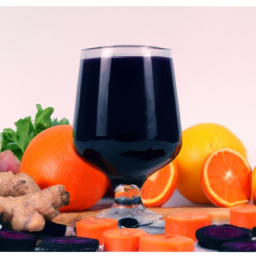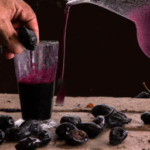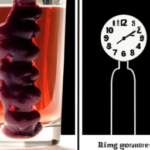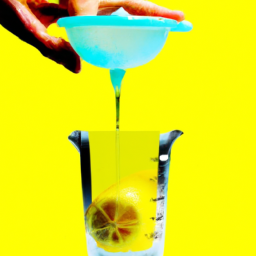After taking my initial sip of prune juice, I couldn’t help but make a face. The flavor was so intense that the thought of consuming it daily for its health advantages seemed unattainable. Nonetheless, after some trial and error with different mixtures, I found that it is feasible to savor the taste of prune juice while still enjoying its numerous health benefits.
Prune juice may not be the most appealing drink, but it is packed with nutrients that are essential for our overall health. From improving digestion to preventing chronic diseases, prune juice is a powerhouse of vitamins and minerals. However, the key to incorporating prune juice into your daily routine is finding a way to make it taste good.
In this article, I will share some tips and tricks on how to make prune juice taste delicious while still reaping all of its health benefits.
Key Takeaways
- Natural sweeteners like honey or maple syrup can balance out the tartness of prune juice.
- Experimenting with flavor combinations like ginger or lemon juice can enhance the taste of prune juice.
- Mixing prune juice with other fruit juices like apple, pear, and grape adds complexity to the flavor.
- Adding healthy ingredients like ginger, lemon juice, and cinnamon can boost the nutritional value and enhance the flavor of prune juice.
The Health Benefits of Prune Juice
You might not realize all the health benefits you can get from drinking prune juice, but it’s worth exploring. Prune juice is a natural laxative that can help regulate digestion, making it a great option for those who experience constipation or other digestive issues.
The high fiber content in prune juice can also help lower cholesterol levels and reduce the risk of heart disease. In addition to its digestive benefits, prune juice can also support bone health. Prunes are packed with nutrients like vitamin K, magnesium, and potassium, which are essential for building and maintaining strong bones.
Drinking prune juice regularly can help reduce the risk of bone fractures and osteoporosis. So, if you’re looking for a simple way to improve your digestive health and strengthen your bones, consider adding prune juice to your diet. When it comes to making prune juice taste good, there are a few things to keep in mind.
Understanding the taste of prune juice is the first step in finding ways to enhance its flavor. So, let’s dive into the taste profile of prune juice and explore some ways to make it more palatable.
Understand the Taste of Prune Juice
As someone who’s tried prune juice before, I know it can have a unique taste that may not be everyone’s cup of tea. However, it’s important to understand what to expect when drinking prune juice and to identify its flavor notes.
This can help you better appreciate the benefits of prune juice and potentially find ways to make it more palatable to your taste buds.
Knowing What to Expect
When making prune juice, there are a few things to keep in mind to ensure that the taste is enjoyable and not overwhelming. First, it’s important to know the texture of prune juice. It’s typically thicker than other juices and has a slightly gritty texture. This can be off-putting to some people, so it’s important to be aware of it and adjust accordingly.
Another thing to consider is finding the right temperature for the juice. Some people prefer it cold, while others prefer it at room temperature or even slightly warmed up. Experimenting with different temperatures can help you find what works best for you. Additionally, if you’re making fresh juice, the temperature of the fruit itself can also make a difference in flavor. For example, learning **how to boil grapes for juice** can result in a deeper, more concentrated flavor, perfect for those who enjoy a richer taste. This method also allows you to experiment with the sweetness since you have more control over the extraction process.
Additionally, adding a sweetener like honey or mixing it with another juice can be helpful in balancing the flavor and making it more palatable. To identify the flavor notes in prune juice, it’s important to pay attention to the taste. Does it have a tart or sweet flavor? Is it earthy or fruity? These are all things to consider when trying to improve the taste of prune juice.
By experimenting with different additions and paying attention to the flavor profile, you can find a way to make prune juice taste good for you.
Identifying the Flavor Notes
Discovering the unique flavor profile of prune juice can be a fun and exciting adventure for those looking to make it taste better. Prune juice has a distinct taste profile that can be described as earthy, fruity, and slightly tart.
The earthy flavor comes from the high fiber content of prunes while the fruity and tart notes come from the natural sugars and acids in the fruit. When trying to make prune juice taste better, it’s important to consider your taste preferences.
If you enjoy sweeter drinks, adding natural sweeteners like honey or agave syrup can help balance out the tartness of the juice. Additionally, experimenting with different flavor combinations like adding ginger or lemon juice can also enhance the overall taste.
With a little bit of experimentation and an open mind, making prune juice taste good can be a delicious and rewarding experience.
Add Natural Sweeteners
To make prune juice taste better, you can sweeten it naturally by adding honey or maple syrup – don’t you want a healthier alternative to refined sugars? Artificial sweeteners may be tempting, but they can leave a chemical aftertaste and aren’t always the best choice for our bodies. Balancing flavors is important, and natural sweeteners can help with this.
Here are some ways to add natural sweetness to your prune juice:
- Drizzle honey over the top of your prune juice for a subtle sweetness that won’t overpower the other flavors.
- Stir in a splash of maple syrup for a more pronounced sweetness and a hint of maple flavor.
- Add a few drops of liquid stevia for sweetness without the calories or glycemic impact of sugar.
- Mix in a mashed ripe banana for a creamy, naturally sweet addition that also adds some thickness to the juice.
Incorporating natural sweeteners is a simple way to make prune juice more palatable and enjoyable to drink. However, if you’re looking for even more flavor, incorporating other fruit juices can also be a great option.
Incorporate Other Fruit Juices
If you’re looking to mix things up, try blending in other fruit juices for a more complex flavor profile. Prune juice pairs well with a variety of other fruits, such as apple, pear, and grape.
Apple juice can add a sweet and tangy flavor to prune juice, while pear juice can add a subtle sweetness. Mixing in grape juice can add a touch of tartness and complexity to the overall taste. Experiment with different fruit pairings and flavor combinations until you find a blend that you enjoy.
Incorporating other fruit juices is a great way to make prune juice taste good without adding any artificial sweeteners or additional sugar. Plus, it’s a simple and easy way to get more variety and nutrients in your diet.
However, if you still find the flavor too strong, you can always dilute it with water or mix it with sparkling water for a refreshing twist.
Mix with Sparkling Water
Adding a bubbly twist to your prune juice is effortless and satisfying by mixing it with sparkling water. Sparkling water mixtures have been gaining popularity as an alternative beverage option due to their low calorie and sugar content. By mixing prune juice with sparkling water, you can create a refreshing and healthy drink that is perfect for any occasion.
To make a delicious prune and sparkling water mixture, simply mix equal parts of prune juice and sparkling water in a glass filled with ice. To add some variety to your drink, you can also experiment with different sparkling water flavors such as lemon or lime. Here is a table that shows some popular sparkling water brands and their nutritional content:
| Brand | Serving Size | Calories | Sugar |
|---|---|---|---|
| La Croix | 1 can (12 oz) | 0 | 0 |
| Spindrift | 1 can (12 oz) | 15 | 1 g |
| Bubly | 1 can (12 oz) | 0 | 0 |
Mixing prune juice with sparkling water is a great way to add some fizz and flavor to your drink while also keeping it healthy. For an extra boost of nutrition, try adding some healthy ingredients to your mixture.
Add Healthy Ingredients
I’ve found that adding healthy ingredients to my prune juice not only boosts its nutritional value but also enhances its flavor.
Three ingredients that I particularly recommend are ginger, lemon juice, and cinnamon.
Ginger adds a spicy kick and helps with digestion, while lemon juice gives a refreshing and tangy taste.
Cinnamon, on the other hand, adds a warm and sweet flavor, and has been shown to have anti-inflammatory properties.
Ginger
You definitely don’t want to skip out on the ginger if you want your prune juice to taste like a spicy, earthy disaster. Not only does ginger add a flavorful kick to the drink, it also has numerous health benefits. Ginger has been shown to aid in digestion, reduce inflammation, and even relieve nausea. Incorporating ginger into your prune juice is a great way to boost its nutritional value and make it more palatable.
To make a ginger prune juice, start by gathering your ingredients. You will need prune juice, fresh ginger root, and honey. Begin by grating a small amount of ginger (about 1 tablespoon) into a bowl. Add in 1-2 teaspoons of honey and mix well. Pour the mixture into a glass of prune juice and stir until well combined. You can adjust the amount of ginger and honey to suit your taste preferences. This simple recipe is a great way to add some spice and digestive health benefits to your prune juice.
As we move on to discussing the benefits of lemon juice, keep in mind that adding a splash of lemon to your ginger prune juice can also enhance the flavor and provide additional health benefits.
Lemon Juice
When life gives you lemons, don’t just make lemonade. Add a splash of lemon juice to your prune juice to give it a refreshing twist.
Aside from its tangy taste, lemon juice has numerous health benefits that can enhance the nutritional value of your drink. It’s packed with vitamin C, which is essential for boosting your immune system and fighting off infections. It also contains antioxidants that protect your cells from free radicals and prevent oxidative stress.
If you’re looking for ways to incorporate lemon juice into your prune juice recipe, there are plenty of options to choose from. You can simply squeeze a fresh lemon into your glass of prune juice or blend it in a juicer for a smoother texture. You can also mix it with honey and ginger for a zesty and soothing elixir.
Experiment with different lemon juice recipes to find the one that suits your taste buds and health goals. Adding cinnamon to your lemon prune juice can take its taste and health benefits to the next level.
Cinnamon
Spice up your morning routine by adding a sprinkle of cinnamon to your favorite fruit juice. Cinnamon not only adds a warm and comforting flavor, but it also has health benefits such as reducing inflammation and stabilizing blood sugar levels.
Here are some cinnamon recipes and pairing options to make your prune juice taste good:
- Cinnamon apple juice: Mix prune juice with apple juice and sprinkle cinnamon on top for a sweet and spicy flavor.
- Cinnamon honey prune juice: Add a teaspoon of honey and a dash of cinnamon to your prune juice for a natural sweetener.
- Cinnamon ginger prune juice: If you enjoy a bit of spice, add fresh ginger and cinnamon to your prune juice for a zesty kick.
- Cinnamon orange prune juice: Mix prune juice with freshly squeezed orange juice and sprinkle cinnamon on top for a citrusy and spicy combination.
- Cinnamon vanilla prune juice: Add a drop of vanilla extract and a sprinkle of cinnamon to your prune juice for a rich and comforting flavor.
To make a smoothie, blend your favorite fruits with prune juice and a handful of spinach for added nutrients.
Make a Smoothie
To create a tasty prune juice smoothie, blend the prunes with creamy yogurt and a splash of honey. This will result in a velvety texture like a luxurious silk robe. Smoothie recipes are a great way to incorporate prune juice into your diet, especially if you find the taste unappealing.
Adding yogurt not only helps with the texture, but it also provides a good source of protein and calcium. The honey sweetens the smoothie without adding refined sugars, making it a healthier option. Alternative options for this smoothie recipe include adding frozen berries for an extra burst of flavor or swapping the yogurt for almond milk for a dairy-free option.
Experimenting with different recipes is key to finding the perfect combination for you. Don’t be afraid to try new things and add your own twist to the recipe. With a little creativity, you can turn prune juice from a bland drink into a delicious and nutritious smoothie.
Experiment with Different Recipes
Experimenting with different ingredients and flavors can elevate a prune juice smoothie from a simple beverage to a gourmet treat. Recipe suggestions, such as adding frozen berries, a splash of vanilla extract, or a spoonful of honey, can enhance the taste of the prune juice smoothie. Additionally, taste preferences can vary greatly from person to person, so trying out different combinations can help find the perfect balance of flavors.
Another way to experiment with prune juice is to use it as a base for a fruit smoothie. Adding other fruits, such as bananas, apples, or kiwis, can not only improve the taste but also provide additional nutrients. Consider blending in some spinach or kale for a boost of greens.
There are endless possibilities when it comes to creating a delicious prune juice smoothie, so don’t be afraid to get creative with it. If experimenting with various recipes still doesn’t appeal to you, consider prune juice concentrate as an alternative. This option allows you to add a concentrated amount of prune flavor to any beverage or recipe without having to worry about altering the taste too much.
Consider Prune Juice Concentrate
If you’re looking for a simple way to add a burst of prune flavor to your favorite recipes, consider using prune juice concentrate as an alternative. Prune juice concentrate offers a strong and concentrated flavor profile that can be added to various recipes, such as marinades, sauces, and dressings.
It’s also a great alternative to using fresh prunes or prune juice, as it’s easier to find and store. When choosing a prune juice concentrate, it’s important to consider the flavor profile. Some concentrate brands may have a sweeter or stronger flavor than others, so it’s best to experiment with a few brands to find the one that best suits your taste preferences.
Once you find the right brand, you can use prune juice concentrate to add a rich, fruity twist to your favorite recipes, while also enjoying the health benefits of prunes.
Enjoy the Health Benefits of Prune Juice with a Delicious Flavor
If you’re looking to make prune juice taste good, consider prune juice concentrate as a starting point. It’s a concentrated form of prune juice that’s more flavorful and potent than regular prune juice. But there are still ways to improve the taste of prune juice.
In this section, I’ll provide some tips and tricks for enjoying the health benefits of prune juice with a delicious flavor. When it comes to prune juice, many people find the flavor to be too strong or unpleasant. But with a little creativity, you can make prune juice taste great. Here are five ideas to get you started:
- Add a splash of lemon juice to your prune juice for a refreshing twist.
- Blend prune juice with other fruit juices, like apple or orange, for a more complex flavor profile.
- Use prune juice as a base for smoothies and add your favorite fruits, vegetables, and protein powders.
- Mix prune juice with sparkling water and enjoy as a fizzy, low-sugar alternative to soda.
- Experiment with prune juice recipes and pairings to find your perfect flavor combination.
Frequently Asked Questions
How many prunes should I use to make prune juice?
I experimented with different Prune Juice Concentrations and found that using 5-6 prunes for every 8 oz of water produced a balanced flavor. Juicing Techniques: Blending resulted in a smoother texture, while Pressing yielded a thicker consistency.
Can I use artificial sweeteners to make prune juice taste better?
Artificial sweeteners can be used as alternatives to sugar in prune juice to make it taste better. Tips for masking the flavor include adding citrus or berries, or blending with other juices.
Is it safe to drink prune juice every day?
Drinking prune juice daily can benefit digestion, heart health, and bone density. However, excessive consumption may lead to diarrhea and abdominal discomfort. Consult a doctor before making it a regular part of your diet.
Can I mix prune juice with milk or dairy products?
Mixing prune juice with dairy products may not be the best idea due to potential digestive issues. Alternatives to enhance its taste include adding honey or mixing with apple juice. Evidence suggests daily intake of prune juice can have health benefits.
How long does homemade prune juice last in the fridge?
Homemade prune juice can last up to a week in the fridge if stored in an airtight container. It contains fiber, antioxidants, and minerals that offer various prune juice benefits. However, refrigeration may alter its taste and texture.
Conclusion
Well, I must say, after trying all these different methods to make prune juice taste good, I’m a true believer that anything is possible!
Who knew that something so healthy could actually taste delicious? The health benefits of prune juice are truly remarkable, and now that I’ve found ways to enjoy its taste, I can’t imagine going without it in my diet.
Adding natural sweeteners like honey or agave syrup, incorporating other fruit juices, mixing with sparkling water, and making a smoothie are just a few of the ways you can make prune juice taste good. And if you want to take it to the next level, try experimenting with different recipes or using prune juice concentrate.
Trust me, the possibilities are endless, and the benefits are worth it. So go ahead, give prune juice a chance, and enjoy the health benefits with a yummy, refreshing taste.
Cindy thoroughly researches juicing trends, techniques, and recipes to provide readers with practical advice and inspiration. Her writing style is accessible, engaging, and designed to make complex concepts easy to understand. Cindy’s dedication to promoting the advantages of juicing shines through her work, empowering readers to make positive changes in their lives through the simple act of juicing.

















